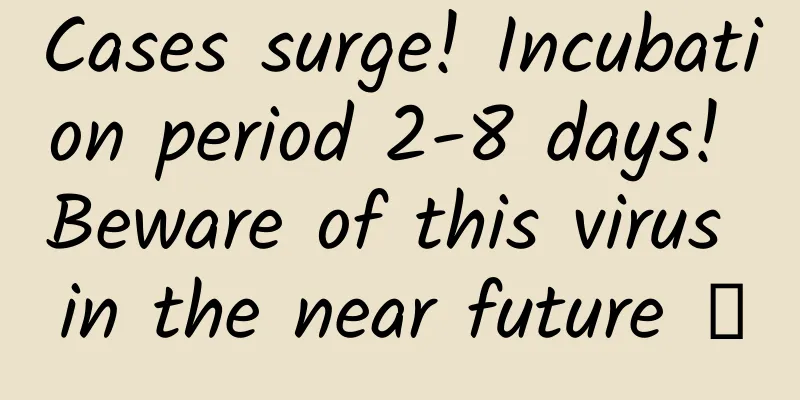Cases surge! Incubation period 2-8 days! Beware of this virus in the near future →

|
Recently, the COVID-19 epidemic situation in China has become more stable, and the overall positive trend continues to consolidate. Experts remind that winter and spring are the peak seasons for various respiratory infectious diseases. In addition to the COVID-19, some other pathogens can also attack the human respiratory tract and lungs, such as influenza virus and human respiratory syncytial virus, and prevention and treatment should also be done well. Recently, the HRSV virus has attracted global attention, and related children cases have surged in European and American countries. The Chinese Center for Disease Control and Prevention has released a Q&A on the prevention and treatment of human respiratory syncytial virus (HRSV) infection diseases, introducing authoritative knowledge about the HRSV virus. 01 What is HRSV? According to information released by the Health Communication Center of the Chinese Center for Disease Control and Prevention, HRSV is an RNA virus of the Pneumoviridae family and the Orthopenivirus genus. After HRSV infection, the incubation period is usually 2-8 days, and the clinical manifestations are mainly respiratory tract infection symptoms. Early HRSV infection is mostly limited to the upper respiratory tract, with clinical manifestations such as nasal congestion, runny nose, cough and hoarseness. Copyright image, no permission to reprint Most symptoms of children infected with HRSV will disappear on their own within 1-2 weeks. A small number may develop lower respiratory tract infections, mainly manifested as bronchiolitis or pneumonia, which are more common in infants under 2 years old. Clinical symptoms include coughing and wheezing. In very rare cases, the symptoms may further worsen and develop shortness of breath and feeding difficulties. Severe cases may develop into respiratory failure. "For children, we need to pay attention to the impact caused by respiratory syncytial virus infection." Xu Wenbo, director of the Institute of Viral Diseases of the Chinese Center for Disease Control and Prevention, said that people of all ages can be infected with HRSV, but the high-risk groups for HRSV infection are mainly concentrated in children, the elderly and people with impaired immune function . 02 How is HRSV spread? In terms of transmission routes, both symptomatic HRSV-infected persons and asymptomatic latently infected persons can spread the virus, usually through the following routes: The first is contact transmission , such as when the nasopharyngeal mucosa or ocular mucosa comes into contact with secretions or contaminants containing the virus; The second is close contact with the patient and causing him to cough or sneeze . 03 Is the chance of developing severe illness after being infected with HRSV high? Which groups of people are more likely to develop severe illness? First of all, it should be noted that infection with HRSV does not form permanent immunity, and it is possible to be infected multiple times afterwards. It is the most common cause of pneumonia and bronchiolitis in infants and young children. Every year, there are about 33.1 million new cases of acute lower respiratory tract infection caused by HRSV in children under the age of 5 years old worldwide, of which about 10% require hospitalization and about 2%-5% of hospitalized children die. Young children and people over 60 years old are more likely to develop severe symptoms after infection. 04 What symptoms of HRSV infection require immediate medical attention? In addition to causing respiratory diseases, HRSV infection can also lead to other systemic diseases, such as: involvement of the cardiovascular system may cause myocardial damage, heart failure, etc.; involvement of the central nervous system may cause central respiratory apnea, epilepsy, encephalitis, etc.; in addition, in very rare cases, hypothermia, rash, thrombocytopenia and conjunctivitis may occur. If your baby has typical respiratory symptoms, including increased respiratory rate, coughing, wheezing , accompanied by irritability or feeding difficulties, "three-depression sign" when inhaling or other abnormal conditions, it is recommended to seek medical attention promptly. 05 How to treat HRSV infection? Can I take my own medication at home? Most early childhood infections are limited to the upper respiratory tract, manifested by fever, nasal congestion, runny nose, mild cough, etc. During this period, children can be observed at home and treated with symptomatic medications such as antipyretics and cold medicines. However, if the child develops lower respiratory tract symptoms or other serious manifestations , such as persistent high fever, fever for more than 3 days, worsening cough, wheezing, or even ugly complexion, rapid breathing, labored breathing, difficulty feeding, convulsions, etc., medical attention is needed immediately and not treatment at home . 06 What is the prevalence of HRSV virus in our country? my country is one of the countries with a high incidence of HRSV in the world. Studies have shown that among the pathogens of acute respiratory tract infection cases in my country from 2009 to 2019, influenza virus, HRSV and human rhinovirus were the top three viral pathogens detected in the whole population, accounting for 28.5%, 16.8% and 16.7% respectively; in children, HRSV was the most detected virus among viral pathogens, with a detection rate of 25.7%, much higher than influenza (14.2%); the detection rate gradually decreased in school-age children (8.1%) and adults (4.5%); and the detection rate slightly increased in the elderly (7.4%). 07 How to prevent HRSV infection? Gao Zhancheng, director of the Department of Respiratory Medicine at Peking University People's Hospital, said that for prevention among susceptible populations, they should pay attention to washing hands frequently, avoid touching their eyes, mouth, and nose with unclean hands, develop good personal hygiene habits, wear masks in a timely manner, and reduce the number of people entering and leaving crowded places. Questions and Answers on the Prevention and Treatment of Human Respiratory Syncytial Virus Infection Full text illustration Source: China News Service, China Disease Control News, Xinhua News Agency, Xinhua Daily Health, Upstream News, etc. The cover image and the images in this article are from the copyright library Reproduction of image content is not authorized |
<<: Take you to understand the design details of the Chinese space station cabin
Recommend
Heat stroke? Summer cold? ——Tell you how to identify and prevent it
This is the 4402nd article of Da Yi Xiao Hu "...
5 formulas you must master for e-commerce operations
1. Sales formula Sales = impressions * click-throu...
Case Analysis | WeChat Reading VS Douban Reading, social ecology or original platform?
As a heavy user of reading apps, the author succe...
This kind of fleshy lump in the stomach may turn into colon cancer! Check it out as soon as possible at this age...
Advice to friends over 40 years old Include colon...
Aiti Tribe Stories (7): Meet 51CTO and aim high
[51CTO.com original article] The protagonist of t...
Outlook for brand marketing trends in 2022!
During the epidemic, "growth" is less e...
Complete method for landing page optimization in the education industry!
Users in the education industry are becoming more...
Can you take away all the dirt with just one spray? Another day of being cheated by short videos
If you often visit Douyin, you must have been rec...
When developing mobile apps, you should avoid these 5 details
The popularity of smartphones has led to the birt...
“The Three-Body Problem” animation is released. Can the high-tech “space elevator” become a reality?
Space elevators have been a frequently mentioned ...
In-depth analysis of the AMS startup process
[[432146]] Preface AMS (ActivityManagerService) i...
Why is the effect of increasing followers not ideal? 7 words to make you fission king
Having missed the traffic bonus period, it seems ...
Increase followers, promotion, IP building, and Weibo operation skills!
Weibo is a social networking platform with great ...
The strange iPhone 6: Gold is out of favor
After iPhone 6/6 Plus went on sale on the 17th, a...
Samsung designer explains S5 design concept: plastic shell feels better
Although Samsung is now the world's number on...









